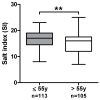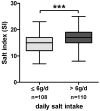Salt-Intake-Related Behavior Varies between Sexes and Is Strongly Associated with Daily Salt Consumption in Obese Patients at High Risk for MASLD
- PMID: 37764734
- PMCID: PMC10534674
- DOI: 10.3390/nu15183942
Salt-Intake-Related Behavior Varies between Sexes and Is Strongly Associated with Daily Salt Consumption in Obese Patients at High Risk for MASLD
Abstract
Background: Metabolic dysfunction-associated steatotic liver disease (MASLD) imposes a significant burden on Westernized regions. The Western diet, high in salt intake, significantly contributes to disease development. However, there are a lack of data on salt literacy and salt intake among MASLD patients in Germany. Our study aims to analyze daily salt intake and salt-intake-related behavior in MASLD patients.
Methods: 234 MASLD patients were prospectively included. Daily salt intake and salt-intake-related behavior were assessed via a food frequency questionnaire (FFQ-DEGS) and a salt questionnaire (SINU). Statistical analyses were performed using SPSS.
Results: Mean daily salt intake was higher in men than in women (7.3 ± 5 g/d vs. 5.3 ± 4 g/d; p < 0.001). There was significant agreement between increased daily salt intake (>6 g/d) and the behavioral salt index (SI) (p < 0.001). Men exhibited higher SI scores compared to women, indicating lower awareness of salt in everyday life. Multivariate analysis identified specific salt-intake-related behaviors impacting daily salt consumption.
Conclusions: Our study reveals a strong link between daily salt intake and salt-intake-related behavior, highlighting sex-specific differences in an MASLD cohort. To enhance patient care in high-cardiovascular-risk populations, specific behavioral approaches may be considered, including salt awareness, to improve adherence to lifestyle changes, particularly in male patients.
Keywords: MASLD; salt consumption; salt-intake-related behavior; steatotic liver disease.
Conflict of interest statement
The authors declare no conflict of interest.
Figures






Similar articles
-
Metabolic Dysfunction-Associated Steatotic Liver Disease in Japan: Prevalence Trends and Clinical Background in the 10 Years before the Coronavirus Disease 2019 Pandemic.Medicina (Kaunas). 2024 Aug 16;60(8):1330. doi: 10.3390/medicina60081330. Medicina (Kaunas). 2024. PMID: 39202611 Free PMC article.
-
Fructose Intake and Unhealthy Eating Habits Are Associated with MASLD in Pediatric Obesity: A Cross-Sectional Pilot Study.Nutrients. 2025 Feb 10;17(4):631. doi: 10.3390/nu17040631. Nutrients. 2025. PMID: 40004960 Free PMC article.
-
Adherence to a healthy lifestyle including sleep and sedentary behaviors and risk of metabolic dysfunction-associated steatotic liver disease in Chinese adults.Prev Med. 2024 Jul;184:107971. doi: 10.1016/j.ypmed.2024.107971. Epub 2024 Apr 23. Prev Med. 2024. PMID: 38657685
-
Metabolic-Dysfunction-Associated Steatotic Liver Disease-Its Pathophysiology, Association with Atherosclerosis and Cardiovascular Disease, and Treatments.Int J Mol Sci. 2023 Oct 23;24(20):15473. doi: 10.3390/ijms242015473. Int J Mol Sci. 2023. PMID: 37895151 Free PMC article. Review.
-
Implications of Protein and Sarcopenia in the Prognosis, Treatment, and Management of Metabolic Dysfunction-Associated Steatotic Liver Disease (MASLD).Nutrients. 2024 Feb 26;16(5):658. doi: 10.3390/nu16050658. Nutrients. 2024. PMID: 38474786 Free PMC article. Review.
Cited by
-
The Importance of Nutrition in Menopause and Perimenopause-A Review.Nutrients. 2023 Dec 21;16(1):27. doi: 10.3390/nu16010027. Nutrients. 2023. PMID: 38201856 Free PMC article. Review.
-
MASLD: Prevalence, Mechanisms, and Sex-Based Therapies in Postmenopausal Women.Biomedicines. 2025 Apr 2;13(4):855. doi: 10.3390/biomedicines13040855. Biomedicines. 2025. PMID: 40299427 Free PMC article. Review.
-
Fatty Liver Index (FLI) is the best score to predict MASLD with 50% lower cut-off value in women than in men.Biol Sex Differ. 2024 May 17;15(1):43. doi: 10.1186/s13293-024-00617-z. Biol Sex Differ. 2024. PMID: 38760802 Free PMC article.
-
Special correlation between diet and MASLD: positive or negative?Cell Biosci. 2025 Apr 12;15(1):44. doi: 10.1186/s13578-025-01382-1. Cell Biosci. 2025. PMID: 40221799 Free PMC article. Review.
-
Adding salt to foods and risk of metabolic dysfunction-associated steatotic liver disease and other chronic liver diseases.Eur J Nutr. 2025 Jun 21;64(5):224. doi: 10.1007/s00394-025-03745-3. Eur J Nutr. 2025. PMID: 40542866 Free PMC article.
References
-
- Estes C., Anstee Q.M., Arias-Loste M.T., Bantel H., Bellentani S., Caballeria J., Colombo M., Craxi A., Crespo J., Day C.P., et al. Modeling NAFLD disease burden in China, France, Germany, Italy, Japan, Spain, United Kingdom, and United States for the period 2016–2030. J. Hepatol. 2018;69:896–904. doi: 10.1016/j.jhep.2018.05.036. - DOI - PubMed
MeSH terms
Substances
LinkOut - more resources
Full Text Sources
Medical

